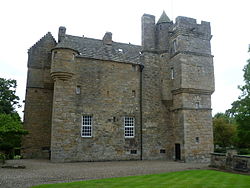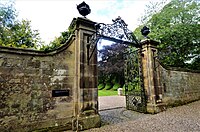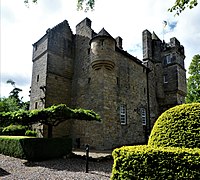Fordell Castle
| Fordell Castle | |
|
Fife | |
|---|---|
 Fordell Castle | |
| Type: | Tower house |
| Location | |
| Grid reference: | NT14698539 |
| Location: | 56°3’13"N, 3°22’17"W |
| History | |
| Information | |
| Condition: | Restored |
Fordell Castle is a restored 16th-century tower house in Fife a mile and a quarter north-west of Dalgety Bay on the county's south coast and two miles east of Dunfermline. Parts of the castle date from before 1566, though most dates from 1580 or later. The chapel was rebuilt in 1650. The interior of the castle was substantially renovated in the 1960s, with additional major renovations to the castle interiors and chapel in the early 2000s. The estate is in private ownership (and not available for public visits).
The castle is a Category A listed building.[1]
Architecture

The castle is a fortified house or 'fortalice' designed on a Z-plan running east-west, with square towers at the north-west and south-east corners, each containing a circular staircase.[2][3]
"Externally, Fordell remains pretty much as it was when first built, a simply treated, dignified dwelling, on which corbelled turetts and projections, happily grouped, relieve the plane wall-surfaces below."[4]


Fordell Castle is the only example of a tower house with two main stairs, each with its own door to the outside.[5][6] The entrance is at the foot of the north stair tower and is through a studded door with a metal grate (yett) behind. It gives access to a vestibule. Stairs lead down to three vaulted basement chambers.[3][4] The western chamber included stocks and branks,[2] but the room has since been converted to a wine cellar. A rogue's collar or jougs hangs near the front entrance to the castle.[2][4]
Considered one of the finest details of the castle is the lead gargoyle at the eaves, seen in the north-east view. It "represents a winged four-footed monster, with open mouth and defiant attitude, designed and executed with great spirit."[2]
History

The earliest charter in the Henderson of Fordell papers dates from 1217, when Richard, son of Hugh de Camera, with consent of his wife and son, (also) Richard, granted small parts of the lands of Fordell to the Abbey of Inchcolm.
By 1240, William de Hercht held the lands of Fordell, and later centuries record changing ownership.
It is not known when the original castle structure was constructed, but the main entrance tower is believed to date from the 1400s.
Mary, Queen of Scots, is said to have stayed here when Marion Scott, one of her ladies-in-waiting, married George Henderson, the laird.[7]
James Henderson, 3rd of Fordell, started to extend the castle in 1566. The masons Robert Peris, James Orrok, and others had made good progress building a "house of great quantity" when they were stopped on 5 June 1567 by William Spittal of Luquhat, who claimed a title to the lands of Fordell. In 1568 the castle was damaged by fire, then rebuilt: “The 3 day of Junii [1568], being Thursday, James Hendersone of Fordell has hes place of Fordell brunt by ane suddaine fyre, both the old worke and the new." Evidence of the fire can be seen to the left of the main entrance tower.
During the late 16th century, the Hendersons began working the estate's rich coal seams that came to form the basis of the estate economy.[8][9]

Sir John Henderson rebuilt St Theriot's Chapel in 1650 for use as a family mausoleum.
The castle was damaged by Oliver Cromwell's army troops garrisoned at the castle in 1651.[10]
The Hendersons became baronets in 1694 during the reign of King Charles II.


In the 19th century, the family built a large, new mansion – Fordell House – nearby.[11] Fordell House was demolished in the 20th century, and there is now little visible evidence of its existence.[12]
In the 19th century, Fordell Castle was rarely occupied; the main hall is said to have been converted into a stable for a time.[13] George Mercer-Henderson modernized the castle and installed the gates. The north front was rebuilt in 1855 (designed by Robert Hay).[14][5]
The author James Henderson CBE (no relation of the former lairds), purchased the estate in 1953 and restored the castle to a good standard so that it was inhabited for the first time since 1726. In 1961, Fordell was bought in 1961 by the lawyer politician Sir Nicholas Fairbairn, who used it as a private residence. Following his death in 1995, Nicholas Fairbairn was laid to rest in the crypt below the Chapel of St Theriot on the castle grounds. Thereafter it was sold, and has passed through a number of hands, and been restored and improved.
Grounds
The estate currently encompasses about 210 acres.[15] The entrance to the Castle passes over a bridge, past a weir that formerly held back the waters of the Fordell Burn, and forming a lake that has now all but silted up. Rhododendrons surround the former lake and are a feature of the estate as a whole, lining the avenues through the estate. The castle sits in dense woodland, with very little opportunity to view it from anywhere, other than up close, or from a significant distance to the south-west.
The "Witch Knowe" on the right of the carriage drive was used to burn witches, the last in 1649.[16] The "Gallows-tree" blew down by 1887.
The castle, garden, and Chapel sit within a roughly trapezoidal area enclosed by a rubble barmkin wall, modified on the east side in the 19th century with castellations and a bastion.
The grounds consist of Italianate gardens, designed by Thomas White, Jr. in 1818.[17]
On the west barmkin wall is the bell originally located in the chapel belfry. It is said to have been purchased by Sir John Henderson, 5th Bart. from a local provost for an extravagant price in order to secure that provost's election vote.[18]
To the south of the barmkin wall is a natural spring called St Theriot's Well.[19] Folklore has it that the well has the extraordinary property of securing what one wishes, while drinking of its water.
St Thereota's Chapel
About 70 yards to the south-west of the castle building within the garden boundary is the mortuary chapel of the Henderson family. It was built on the site of an earlier chapel, dedicated to Saint Therotus, Theoretus or Theriot, an obscure 8th century cleric,[20] who is described by one source as "splendidly apocryphal".
Other features on the estate
Close to the Castle, the former Fordell Day Level used to surface. This was a mine "river", connecting the foot of numerous former coal mines, from as far afield as Cowdenbeath, and draining the pits. It was one of Scotland's worst pollution issues, issuing iron-polluted water into the nearby watercourse, but this has been largely improved by the recently completed open-cast mining operations to the North, and the subsequent reparations and reed-bed water treatment facilities.
The remains of one the oldest railways in the north runs 450 yards to the east of the Castle. The Fordell railway route took coal from the Fife coalfields to the ships in St David's Bay, now part of the Dalgety Bay settlement. The original wooden rails are gone, although the embankments, cuttings, and stone bridges remain.
The former entrance avenue and gates to the east lead to Vantage Farm, a small steading featuring a rare octagonal doocot and ornate farm buildings including clock tower, Grieve's cottage, dairy, and three storey granary. The steading is now exclusively residential.
Outside links
| ("Wikimedia Commons" has material about Fordell Castle) |
References
- ↑ Fordell Castle (Category A) - Listing detail (Historic Environment Scotland)
- ↑ 2.0 2.1 2.2 2.3 MacGibbon, D. and Ross, T. (1887): The Castellated and Domestic Architecture of Scotland from the Twelfth to the Eighteenth Century Vol. 2' title page, 237-243.
- ↑ 3.0 3.1 Tranter, Nigel (1986) "The Fortified House in Scotland - Volume 2, Central Scotland" p. 38-39.
- ↑ 4.0 4.1 4.2 Eleventh Report with Inventory of Monuments and Constructions in the Counties of Fife, Kinross, and Clackmannan: Royal Commission on Ancient and Historical Monuments & Constructions of Scotland (1933) p. 96-97.
- ↑ 5.0 5.1 Gifford, John (1992) "Buildings of Scotland: Fife" p. 227.
- ↑ Inglis, Janet (2011) "Scotland’s Castles: Rescued, Rebuilt and Reoccupied, 1945-2010" p. 192 (citing Astaire, Leslie et al. (1997) "Living in Scotland" p. 110).
- ↑ Marilyn Brown, Scotland's Lost Gardens (Edinburgh, 2015), p. 103
- ↑ Fordell Castle - Listing: Inventory of Gardens & Designed Landscapes
- ↑ Holman, Bob (1952) "Behind the Diamond Panes"; see Letters of horning (1628) NRS GD172/284.
- ↑ "Fordell Castle". Gazetteer for Scotland. http://www.scottish-places.info/features/featurefirst6532.html.
- ↑ CANMORE (RCAHMS) record of Fordell House
- ↑ Simpson, Eric (1999) "Dalgety Bay: Heritage and Hidden History" p. 74.
- ↑ Laing (1865) p. xlii (interiors restored, the main hall having previously been turned into a stable); Beveridge (1888) p. 50 (castle unoccupied; open to the public weekly)
- ↑ Dictionary of Scottish Architects: Robert Hay
- ↑ Kirkwood, H. (2007) "10 Best Houses in Scotland" countrylife.co.uk retrieved 2017-11-24.
- ↑ See Arnott, Robin G.K. (1992) "Of Monks and Ministers – the story of the Church in Dalgety" p. 29
- ↑ Tait, A. (1980) "The Landscape Garden in Scotland: 1735-1835" pp. 171, 259 (citing White, T. (1818) "A Design for the Improvement of the Grounds of Fordel" RHP 3803); see also Triggs, H. Inigo (1988) "Formal Gardens in England and Scotland" pp. 43, 166 ISBN 1851490175 (description and drawing of garden c. 1902).
- ↑ Buckner (1881) p. 52.
- ↑ "St Theriot's Well - Holy Well or Sacred Spring in Scotland in Fife". 29 March 2004. http://www.megalithic.co.uk/article.php?sid=8247.
- ↑ "Fordell Castle Chapel" www.scottishchurches.org.uk, Scottish Church Heritage Research Ltd, retrieved 27 August 2017.
